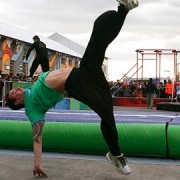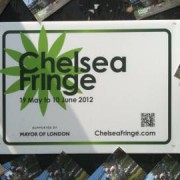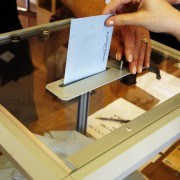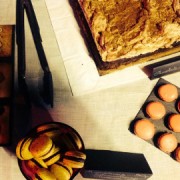
A station of suitcases filled with silk threads at the Museum of Immigration Pic: 19 Princelet Street
Most museums tell stories through collectibles, paintings and statues. This is not the case at 19 Princelet Street.
The Museum of Immigration and Diversity in Spitalfields allow you to experience a journey across time, putting you in the shoes of others to walk the journey they walked.
It is a place that tells human stories of immigrants and refugees who over centuries settled around this part of the East End.
The Museum is only open to the public a few times a year due to lack of funding. Last Sunday, June 18, members of the public were given a rare glimpse of the museum as it opened its doors in support of The Jo Cox Great Get Together movement inspired by the late MP wh0 was murdered last year. It will open for only the second time this year this Sunday, June 25, as part of Refugee Week.

The museum opened its doors for public last Sunday Pic: Marwa Amer
“All of us are immigrants or descended from immigrants. It just depends on how far back you look” – that is the message that appears prominently above suitcases as you make your way into the Museum.
The museum is divided into multiple rooms featuring different aspects of the immigrant experience with people narrating their stories through symbolic objects, recordings and diaries.

Doorway from the past to the present. A rare glimpse inside the historic site Pic: 19 Princelet Street
Samuel Worrall, an English builder and carpenter, built the house in 1719, originally as his home.
It was lived in for many years as a private house. The first refugee occupants were Huguenots who fled persecution in France. Later, it housed other groups of immigrants that came to Spitalfields such as Irish Catholics, Bangladeshi Muslims, and Russian Jews who turned the house’s garden into a small synagogue.
The museum’s main installation, the Suitcases and Sanctuary, was created by school pupils from various parts of East London and Brick Lane. Children from different ancestral backgrounds worked with local artists, poets and historians to imagine being earlier arrivals coming to Britain.
Susie Symes, Chair of Trustees at the Museum of Immigration, considers the museum to be about empathy and connecting human stories.
“A group of Bengali Muslim children, some of them born here in London, were asked to imagine themselves as white 300 years ago [and] to tell the story of Jewish immigrants,” she said.
Children wrote letters, poems and labels to describe why different groups of immigrants left their homes.
The building now is managed by the Spitalfields Centre charity which was set up to preserve 19 Princelet Street and a permanent exhibition and educational resource telling the stories of Britain’s migrant history.

An exhibit explains the reasons many Irish people left their homeland onto the symbol of the famine Pic: 19 Princelet Street
In a suitcase labeled “Why did they leave Ireland?” words written on potatoes describe the famine that made Irish families leave their homes in the 1800s. While the potatoes were few they were enough to capture the sorrow of the time.
Phillip Black, a member of the Advisory Board, believes the museum has increased importance today because its stories reflect what is currently going on in the world.
“In this Brexit time, a place like 19 Princelet Street is quite needed, to understand the past to make a better future. We’ve got to understand migration as a human story, it’s always happened, it’s not new and it will never change.”

Visitors enjoying the Museum’s open day Pic: Marwa Amer
Visitor Joanne Payne, a volunteer English teacher for immigrants, enjoyed listening to recorded poems of the students summarising nostalgia for their homes, families and their loved ones left behind.
“I used to teach refugees through my work. This is not just a museum – it’s a house where you can feel the history of migrants. It’s almost reassuring to understand the difficulties that we are facing now and understand it’s been repeated so many times in history. I have learned something today.”




